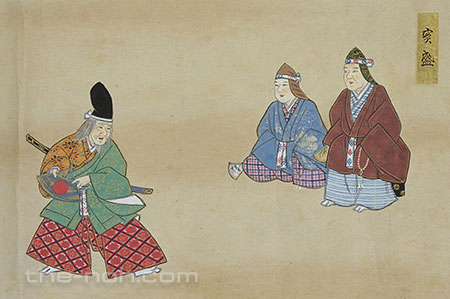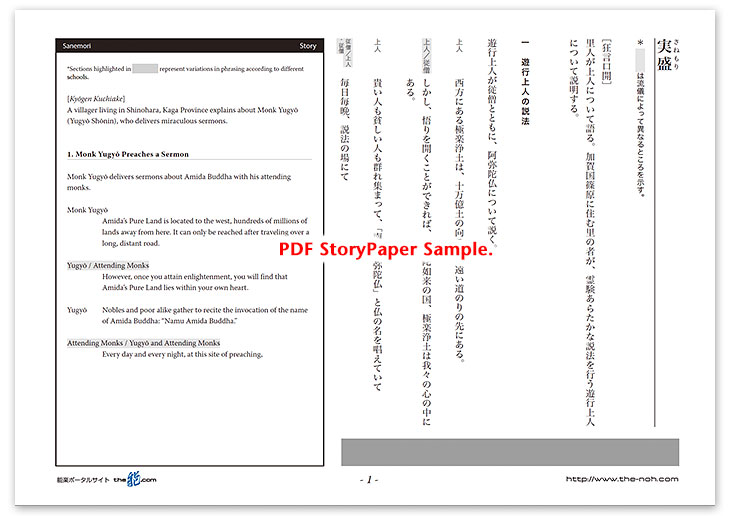
 Sanemori
Sanemori

![]()
Monk Yugyō (Yugyō Shōnin), who is on a pilgrimage to the provinces, has delivered sermons at Shinohara in Kaga Province. One day, Yugyō notices that a certain old man, who has come to listen to his preaching every day, places his hands together reverently before Yugyō. Only Yugyō can see the old man, no one else can, so when he talks to the old man, people around Yugyō wonder why he is talking to himself so strangely. Yugyō asks the faithful old man his name, but the old man does not answer. When Yugyō presses him to answer, the old man requests that Yugyō leave the two of them alone. He tells Yugyō the story of one of the warriors of the Heike troops, Saitō no Bettō Sanemori, who was killed during the Battle of Shinohara and whose severed head was washed in the very pond before their eyes. He further reveals that he is the ghost of Sanemori before disappearing.
Yugyō asks a villager in Shinohara about Sanemori and the battle that happened there and is convinced that the old man is indeed the ghost of Sanemori. He requests the villager to announce to the people of Shinohara that he will conduct a memorial service for Sanemori by reciting Amida’s name while performing dances.
That night, by the pond, Yugyō recites prayers invoking Amida Buddha and there appears the ghost of Sanemori, his hair and beard gray with age, in battle dress. The ghost narrates Sanemori’s story, recounting that when his head was washed for presentation to General Kiso Yoshinaka, the black ink dying his hair was washed away, revealing its natural gray color; that he went to the battle in his homeland dressed in red brocaded hitatare war robes; and his final moments of fighting against Tezuka no Tarō Mitsumori. He then begs Yugyō to pray for him and vanishes into thin air.
![]()
This Noh play, Sanemori, is classified as one of the Three Asura Plays, along with “Tomonaga” and “Yorimasa.” It is also one of the San-Mori Plays (three Noh plays with titles including the word, “mori”) along with “Morihisa” and “Michimori.” This is one of the most difficult pieces of shura-mono (an Asura play, that is, a warrior’s story) to perform and therefore, it is said that an unseasoned Noh performer cannot be assigned this part. In olden days, this piece was also called “Shinohara” or “Shinohara Sanemori.”
This play of Zeami’s is based upon an episode in the Tale of Heike. However, Zeami was clearly inspired by a non-fictional story when he created this drama. In the year 1414, some 230 years after Sanemori’s death, a mysterious rumor spread in Kyoto that the ghost of Sanemori had appeared in Shinohara, Kaga Province, and that Monk Yugyō recited ten invocations of Amida Buddha for the ghost’s sake. Indeed, this rumor forms the basis of this play, Sanemori.
Most shura-mono plays start by depicting mae-shite (the lead character) as a living person and eventually reveal that he is actually a ghost. However, in this piece, the lead character, Sanemori, is an invisible being from the beginning. No one but Monk Yugyō can see or hear him. Therefore, from the outset, the audience can recognize Sanemori as a ghost. This dramatic structure makes Sanamori very unusual among shura-mono, together with its unique opening that starts with Kyōgen Kuchiake (opening by Kyōgen-kata).
So heroic and determined was this old warrior, Sanemori, that he even dyed his hair black and spearheaded the rush toward the enemy but, in sharp contrast, this play sadly and pitifully describes the final moments of Sanemori, who is slowly losing his strength and withering like a dead tree.
In the second half of the drama, shite narrates a long war story with movements describing battle scenes; it involves many rigorous physical activities, although the lead character is an old man. The movements considered especially difficult to perform are the scenes of washing the severed head and of fighting against Tezuka no Tarō Mitsumori. Furthermore, the shite performs the roles of three different enemies in the chants: Tezuka; Kiso Yoshinaka; and Higuchi Jirō, who identifies Sanemori’s severed head. The manner in which shite describes these different characters is one of the highlights of this piece.
STORY PAPER : Sanemori
Story Paper presents noh chant stories in modern speech, with story outlines, highlights and more using Adobe PDF format, which can print out and zoom in. Print out the pages and take them with you when you see the actual noh performance.

The copyright of Story Paper is held by the Noh.com. Story Paper is for individual use only. It is prohibited by the copyright law to distribute or publish printed-out Story Paper pages without prior consent. For more information, check the credit and disclaimer pages.



 [Sanemori : Story Paper PDF : 573KB
[Sanemori : Story Paper PDF : 573KB